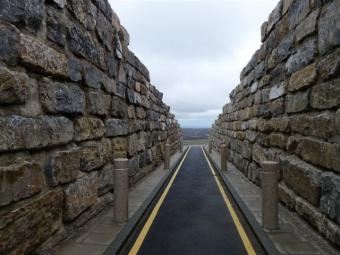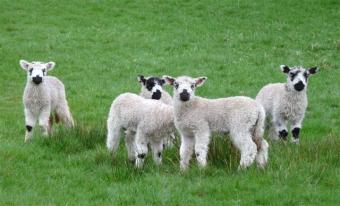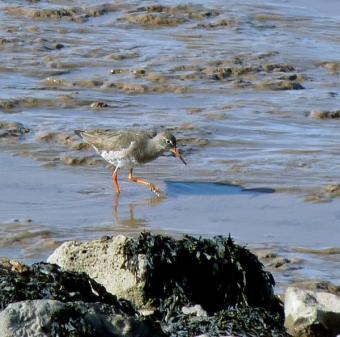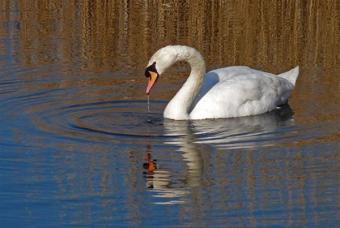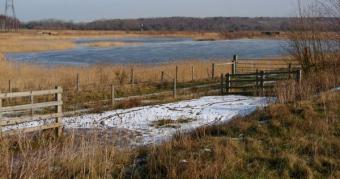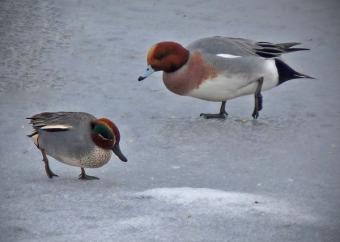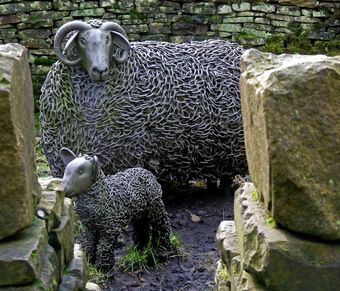WFV, Queensbury Circular, 17th April 2012
 Shibden ValleyQueensbury – altitude 1200 ft; weather forecast - showers and longer outbreaks of rain clearing in the afternoon. Who in their right mind would decide to do a walk in this location when they could quite easily tuck themselves up at home?? Well, there were a few who decided to do just that but eight foolhardly folk turned up at Queensbury Golf Club at 10.00am to join Brian and Eric who had organised today’s walk. We set off in pouring rain wondering why we had bothered and the best part of six hours and five miles later we were back enthusing about what a good day it had been.
The early rain cleared about half an hour into the walk and the weather gradually improved to give superb long distance views as we reached the higher ground and apart from a heavy shower just as we stopped for lunch we enjoyed good weather with good sunny intervals as we descended into and out of the Shibden Valley.
Shibden ValleyQueensbury – altitude 1200 ft; weather forecast - showers and longer outbreaks of rain clearing in the afternoon. Who in their right mind would decide to do a walk in this location when they could quite easily tuck themselves up at home?? Well, there were a few who decided to do just that but eight foolhardly folk turned up at Queensbury Golf Club at 10.00am to join Brian and Eric who had organised today’s walk. We set off in pouring rain wondering why we had bothered and the best part of six hours and five miles later we were back enthusing about what a good day it had been.
The early rain cleared about half an hour into the walk and the weather gradually improved to give superb long distance views as we reached the higher ground and apart from a heavy shower just as we stopped for lunch we enjoyed good weather with good sunny intervals as we descended into and out of the Shibden Valley. 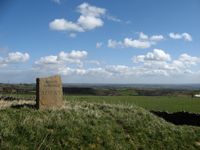 View EastThe views extended from Ogden, Stoodley Pike, over Halifax, the Pennine chain, Holme Moss, Emley Moor, Ferrybridge and Eggborough power stations and all points in between.
Spring was in the air in the form of swallows, chiffchaffs, a skylark, our first willow warblers of the year, green woodpeckers yaffling and great spotted woodpeckers drumming together with 17 other bird species and a small tortoisehell butterfly. On the ground grasses were showing their Spring growth and other early plants were flowering – lots of bilberry and opposite-leaved golden saxifrage joined bluebell, wood anemone, wood sorrel, shining cranesbill, yellow archangel, herb robert, our first meadow buttercup and early dog violet to bring colour to the scene.
View EastThe views extended from Ogden, Stoodley Pike, over Halifax, the Pennine chain, Holme Moss, Emley Moor, Ferrybridge and Eggborough power stations and all points in between.
Spring was in the air in the form of swallows, chiffchaffs, a skylark, our first willow warblers of the year, green woodpeckers yaffling and great spotted woodpeckers drumming together with 17 other bird species and a small tortoisehell butterfly. On the ground grasses were showing their Spring growth and other early plants were flowering – lots of bilberry and opposite-leaved golden saxifrage joined bluebell, wood anemone, wood sorrel, shining cranesbill, yellow archangel, herb robert, our first meadow buttercup and early dog violet to bring colour to the scene. 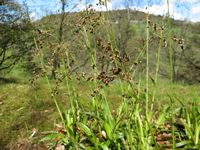 WoodrushWe also found flowering woodrush, scurvy grass and horsetail amongst a host of other plants pushing through the soil.
An excellent walk with lots of interest in many forms. Many thanks to Brian who organised the day with Eric’s assistance and to the other eight members who supported them, all of whom were very pleased that they had made the effort.
WoodrushWe also found flowering woodrush, scurvy grass and horsetail amongst a host of other plants pushing through the soil.
An excellent walk with lots of interest in many forms. Many thanks to Brian who organised the day with Eric’s assistance and to the other eight members who supported them, all of whom were very pleased that they had made the effort.Stuart

